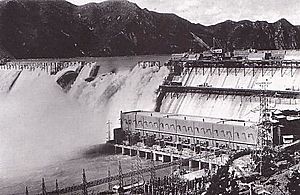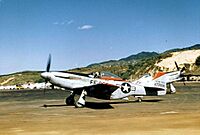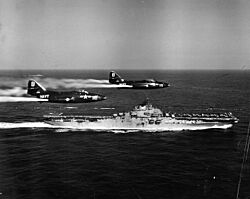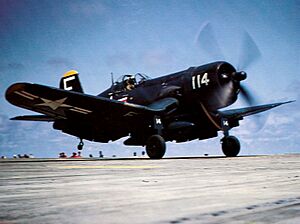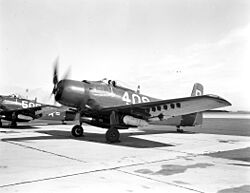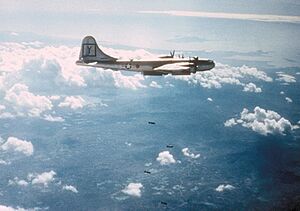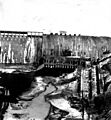Attack on the Sui-ho Dam facts for kids
Quick facts for kids Attack on the Sui-ho Dam |
|||||||
|---|---|---|---|---|---|---|---|
| Part of the bombing of North Korea | |||||||
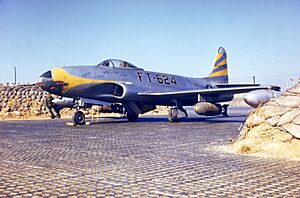 F-80C fighter-bomber of the 8th FBG with wing-mounted bombs |
|||||||
|
|||||||
| Belligerents | |||||||
| Commanders and leaders | |||||||
| Strength | |||||||
87 major AA guns |
|||||||
| Casualties and losses | |||||||
| Five fighter/fighter-bombers lost or written off |
Multiple MiGs shot down/destroyed Permanent destruction of 90% of generating capacity, power outage in North Korea for two weeks and reduction of available power to northeast China by 23% |
||||||
The attack on the Sui-ho Dam was a series of big air attacks during the Korean War. These attacks happened on June 23–24 and June 26–27, 1952. Air forces from the United Nations targeted thirteen power plants that used water to make electricity (called hydroelectric facilities).
The main target was the huge Sui-ho Dam in North Korea. The goal was to put pressure on the peace talks that had stopped at Panmunjeom.
These power plants were heavily protected by planes from the Soviet Union, China, and North Korea. There were also many large anti-aircraft guns.
Over 1,500 flights were made by fighter planes and fighter-bombers. These planes came from the United States Air Force, US Navy, US Marine Corps, and South African Air Force. It was the first time in almost two years that these different air forces worked together on such a large mission.
The attacks destroyed 90% of the targeted power plants. This caused a complete power outage in North Korea for two weeks. It also cut down the electricity available to northeast China by 23%. North Korea later built new power plants, but they didn't get back to their old power levels until after the war ended in 1953.
Politically, the attacks didn't help the peace talks much. Some people in the UK and the United States Congress spoke out against the attacks. This made the attacks less effective as a way to pressure North Korea.
Smaller attacks happened between September 1952 and June 1953. These caused only minor damage. UN forces also attacked smaller power plants in North Korea during the summer of 1952. This was to stop them from making up for the lost power.
Contents
Why the Attacks Happened
North Korea's Power System
The Sui-ho Dam (now called Supung Dam) was built in 1941 by Japan. It was on the Yalu River and was the fourth largest dam in the world at that time.
The dam was 853 meters (2,799 feet) long and 160 meters (525 feet) high. It could hold over 20 billion cubic meters of water. The dam had six large generators, each making 100,000 kilowatts of electricity. This power was used by much of western North Korea and parts of northeast China.
North Korea had five other big hydroelectric systems. Three of these were close together in South Hamgyong Province. Each system had four power plants. These plants were spread out along a river, usually 8 to 16 kilometers (5 to 10 miles) apart.
Planning the Attacks
When the Korean War started, North Korea had six hydroelectric systems and six smaller power plants that burned fuel to make electricity. All of these were important targets for the Joint Chiefs of Staff (JCS) in the US.
At first, the US did not bomb these power plants. This was because they weren't sure if North Korea would be taken over. Also, there was a ban on bombing the Sui-ho Dam from November 1950. This was to avoid making China angry and causing them to join the war. Even after China did join, the ban stayed in place.
By March 1952, the peace talks were stuck. General Otto P. Weyland, who led the US Air Force in the Far East, suggested bombing the power plants. He thought it would help with the talks. But General Matthew Ridgway, the UN commander, said no.
In April 1952, General Mark Clark became the new UN commander. Other new military leaders also wanted to attack the power plants. They believed it would put pressure on the enemy.
Clark asked for plans to attack the power system. Two plans were made: one that included bombing the Sui-ho Dam and one that didn't. The US Joint Chiefs of Staff then suggested to President Harry Truman that the Sui-ho Dam should also be attacked. Truman agreed.
The attack was approved on June 19, 1952. It was planned for June 23 or 24. This allowed four aircraft carriers to be used in the operation. The plan was finalized to include naval aircraft in the attack on Sui-ho.
Air Forces Involved
Many different air units from the United Nations took part in these attacks. They included:
- US Air Force (FEAF): This included fighter-interceptor groups (like the 4th and 51st) and fighter-bomber groups (like the 8th, 18th, 49th, and 136th).
- US Marine Corps (1st Marine Aircraft Wing): This included Marine Aircraft Groups 12 and 33.
- US Navy (Naval Forces Far East): This included Task Force 77, which had four aircraft carriers: Bon Homme Richard, Philippine Sea, Boxer, and Princeton. Each carrier had several air groups with different types of planes.
The planes used were a mix of propeller-driven aircraft like the F4U-4 Corsair and AD-4 Skyraider, and jet aircraft like the F-86E Sabre, F-80C Shooting Star, F-84G, and F9F-2 Panther.

On the other side, the defending forces included:
- Soviet Air Forces (VVS): Their 64th Fighter Aviation Corps had two divisions with 210 combat-ready MiG-15 jets.
- Chinese and North Korean Air Forces: They had a combined force of 275 MiG-15s.
- Anti-aircraft guns: There were 87 major anti-aircraft guns defending the targets.
Air Strikes in June 1952
First Day of Attacks
The attacks were supposed to start at 8:00 AM on June 23. But bad weather with thick clouds caused a delay. Later, the weather cleared, and the attacks were ordered to start at 4:00 PM. The clouds actually helped hide the planes on their way to the targets.
Propeller planes took off earlier than jet planes to arrive at the targets at the same time. The Sui-ho Dam was very close to Chinese airfields where many MiG-15 fighters were based. So, it was important for all planes to arrive together to surprise the enemy.
Eighty-four F-86 Sabres were the first to arrive at Sui-ho. Their job was to protect the bombers from MiG attacks. They also tried to stop MiGs from taking off by flying low over their bases. Even though 160 MiGs took off, they flew deeper into China and did not try to stop the attack.
At 4:00 PM, 35 Navy F9F Panthers started attacking the anti-aircraft guns around the dam. Then, 12 AD Skyraiders began bombing the Sui-ho power stations. They were followed by 23 more Skyraiders, dropping 81 tons of bombs in just over two minutes.
Between 4:10 PM and 5:00 PM, US Air Force jets dropped 145 tons of bombs on the Sui-ho power plant. These were F-84 Thunderjets and F-80 Shooting Stars.
At the same time, other planes attacked the other power plants. F-51 Mustangs and South African planes hit Fusen plants. Marine Skyraiders and Corsairs bombed Choshin plants. Navy planes from the carriers bombed the lower Fusen plants and the Kyosen complex.
On June 23, UN forces flew a total of 410 attack flights. After the attacks, photo-reconnaissance planes flew over the targets to see the damage.
Only a few UN planes were damaged or lost. Two F-80s were damaged by anti-aircraft fire and crashed. One Navy F4U was badly damaged and its pilot was rescued after landing in the water. Other planes had minor damage but returned safely.
Later Missions and Results
Reconnaissance photos showed heavy damage to the Sui-ho, Choshin, Fusen, and Kyosen power plants. Most of these targets were attacked again the next day, June 24, in both morning and afternoon missions.
In the morning, Air Force F-84s and Navy Skyraiders attacked Sui-ho again, believing it was completely destroyed. Other planes hit the remaining Choshin and Kyosen plants.
In the afternoon, planes from the Princeton finished destroying Kyosen No. 3. One Corsair was lost, but the pilot was rescued. Other planes attacked transformer stations along the power grid.
Attacks by B-29 Superfortresses planned for the night of June 24–25 were canceled because the targets had already been hit. After a short break on June 25, Choshin and Fusen were attacked again on June 26–27 to finish the job.
In total, over the four days, UN forces flew 1,276 bombing flights. F-86 Sabres flew another 238 flights to protect the bombers from MiGs. The UN lost five aircraft, but all the pilots were rescued.
About 90% of North Korea's power production was destroyed. Eleven of the thirteen power plants were completely out of action. China lost about 23% of its electricity for its northeast region. For two weeks, North Korea had a total power blackout.
Both China and the Soviet Union quickly sent people to North Korea to fix the damaged generators. For most of the summer of 1952, only about 10% of the old power production was restored.
Political Impact of the Attacks
The attacks did not immediately change the minds of the communist leaders at the peace talks. In the UK, some political leaders criticized the operation. They worried it might lead to a bigger war, even though the attacks were on military targets.
The British Labour Party tried to blame the ruling Conservative Party. They said the US had not properly consulted the British government before the attacks. The British government barely survived a vote in Parliament. The US Secretary of State, Dean Acheson, publicly took the blame. He said the US was wrong for not telling the British "as a courtesy."
In the United States, some members of Congress wondered why it took almost two years to approve these successful attacks. Secretary of Defense Robert A. Lovett gave reasons, but some of them were outdated.
Even though the attacks didn't directly change the peace talks and caused some negative reactions, they became an accepted way for UN forces to put pressure on North Korea.
Later Attacks
Summer 1952 Power Grid Campaign
Within ten days of the big attacks, UN air forces continued to hit the power grid. They wanted to keep it out of service. However, the Sui-ho Dam itself was not targeted again right away.
Navy planes attacked the Kyosen power plants and three plants at Puryŏng-ŭp in early July. These Puryŏng-ŭp plants had not been hit before. Later, on July 8, US Air Force F-84s attacked the Choshin plants.
On July 19, Navy planes bombed Choshin No. 3, hitting its transformer yard. They also noticed that the anti-aircraft defenses were much stronger. On July 23, the power plant at Wonsan was attacked and destroyed for the first time.
Throughout August and September, more attacks happened on various power plants. In all these Navy attacks, no carrier aircraft were lost. B-29 bombers also flew missions against Choshin No. 1.
September 1952 Attack
The United Nations attacked the Sui-ho hydroelectric complex again on the night of September 12–13, 1952. This time, B-26 Invaders and Navy planes helped suppress anti-aircraft fire. Four special B-29 Superfortresses jammed enemy radars. Twenty-five B-29s from the 19th and 307th Bomb Groups bombed the dam.
During the mission, one B-29 crashed due to ice, killing most of its crew. Another B-29 was shot down over Sui-ho, and two more were damaged. The intense anti-aircraft fire and MiG attacks made it hard for the bombers to be accurate.
A Soviet report said that many bombs were dropped, but only a few hit the dam. The dam, generators, and transformers were not damaged. Only a high-voltage cable and some small huts were destroyed.
Even though the US Air Force initially thought they had hit the powerhouse and transformer yards, later photos showed that the complex was still partly working.
February 15, 1953 Attack
Photos still showed that two generators at Sui-ho were working. So, on February 15, 1953, 24 F-84s attacked the complex. They carried two 1000-pound bombs each and were protected by 82 F-86s. No F-84s were lost.
However, 30 MiG-15s attacked the F-86 escorts. The Soviets claimed to shoot down two F-86s, losing one MiG. The F-86 pilots claimed to shoot down four MiGs and had no losses.
May 10, 1953 Attack
Eight F-84s attacked Sui-ho again on May 10, placing three special bombs in the power house. No F-84s were lost. In air fights between the escorts and MiGs, the Chinese claimed one F-86 shot down, but their own MiG pilot was killed. US pilots claimed two MiGs shot down with no losses.
June 7, 1953 Attack
The last attack on the Sui-ho Dam during the Korean War happened on June 7, 1953. Eight F-86F fighter-bombers, disguised as part of a regular patrol, surprised the defenders. They dropped bombs on the power house.
Even after this attack, photos showed that two generators were likely still working. Further attacks were stopped because it was hard to know exactly where the working parts were inside the large power plant.
The purpose of these later attacks was to show the communists that the UN would make the war very costly for them. When the war ended, Sui-ho's No. 6 and 7 generators, and Choshin No. 1, were back in operation.
Images for kids


